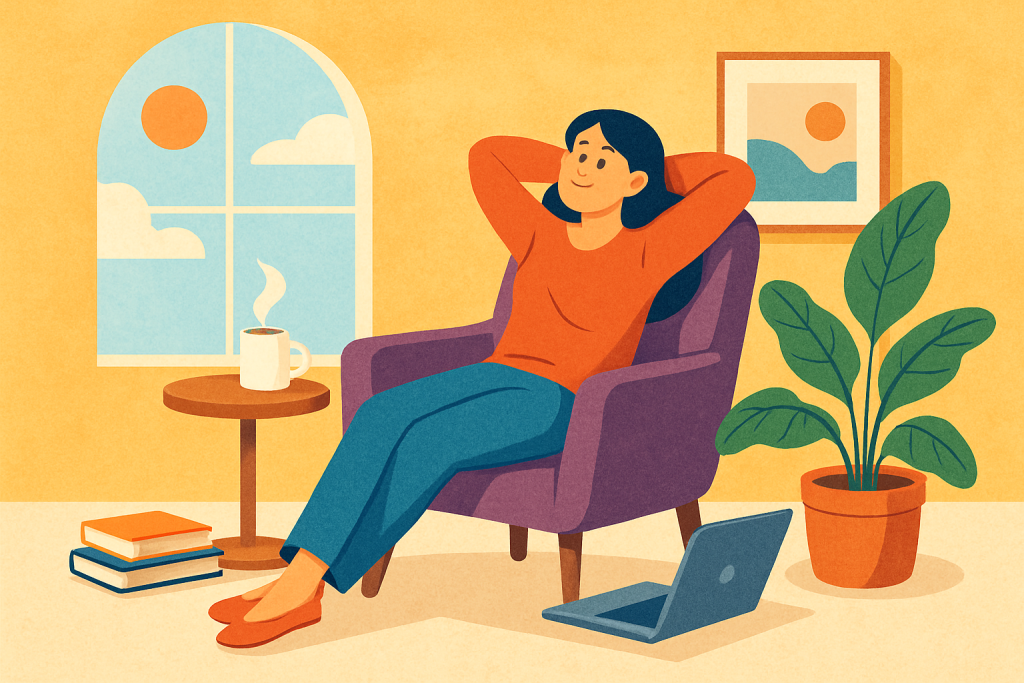Feeling stressed or burned out? Struggling with how to take a break without feeling guilty? Research shows breaks actually enhance focus and motivation. Let’s explore fresh strategies and trends to help you reclaim rest—no guilt attached.

Why We Feel Guilty Taking Breaks
- Work culture glorifies overwork. Gen Z workers are skipping lunch more than others—47% miss meals twice a week due to guilt, although 87% admit breaks boost wellness.
- High-pressure environments amplify shame. A UNC study found employees feel guilty after even legitimate downtime, often working late to “make up for it” unc.edu.
- “Leaveism”: working while supposed to be off. Many people carry unfinished tasks home or on leave—a sign of unhealthy rest boundaries.
These pressures mean many skip rest—even though science says breaks are essential.
How Breaks Boost Your Performance
Understanding the benefits helps reduce guilt:
- Enhanced cognitive focus. Studies show short breaks improve sustained attention and reduce fatigue.
- Better mental health. Regular pauses combat stress and prevent burnout symptoms like cynicism and exhaustion.
- Increased creativity and productivity. Strategic cycles—like 75 min work/33 min rest—have been shown to maximize output.
Emerging Trend: Smart Break Scheduling
Forget random pauses—today’s focus is on structured rest:
- 75/33 rule. Follow one cycle and then rest to reset fully .
- Booster Breaks. Short, group-led breaks incorporating movement or breathing improve health and teamwork.
- Intentional Micro‑breaks. Even 1–5 minutes of stepping away from screens helps combat decision fatigue.
These methods help you integrate breaks mindfully—not just when you’re exhausted.
A 5-Step Guide: How to Take a Break Without Feeling Guilty
1. Embrace the Science
Remember: strategic breaks boost, not dent, productivity. Cite research when explaining this to your boss or yourself—for example, “I’m not procrastinating; research shows this will improve performance” with a source.
2. Use Tech to Automate Breaks
Tools like Pomodoro timers or Slack reminders can prompt breaks, making them feel part of workflow—not optional extras.
3. Schedule Breaks in Your Calendar
Block rest time like a meeting. Making it official reduces internal resistance and sends a clear signal to colleagues.
4. Swap Screens for Movement
Even a short walk, stretch, or deep-breath session recharges your brain more than scrolling. Monash University found that mental resets occur fastest when shifting physical activity .
5. Model Breaks and Build Culture
If you’re in a leadership role—or even a peer—you can influence culture by actually taking breaks. UNC research shows employees mimic leaders’ behaviors .
Overcoming Common Break Guilt Triggers
| Situation | Strategy | Why It Works |
|---|---|---|
| Tight deadlines | Frame break as “productivity boost” | Scientifically accurate |
| Remote work pressure | Show visible commitment—take virtual walks or screens-off breaks | Break stigma reduces when it’s normal |
| Back-to-back meetings | Batch meetings earlier/later, insert buffer for breaks “on camera” | Sets standard for self-care |
Real-World Examples of Guilt-Free Break Strategies
At a tech startup: A team introduced 15 min Booster Breaks at 3 pm daily—group stretches and a coffee social. Productivity went up, burnout rates fell; staff reported feeling more supported.
Freelancers and self-employed: With no enforced schedule, many work in 75/33 cycles using timers like Forest or Be Focused—balancing autonomy and rest.
Hybrid teams: Those working from home push a 3 pm Slack reminder: “5-minute step-away time!” It normalizes micro-breaks—even during video calls.
Long-Term Benefits of a Break-Friendly Routine
- Lower burnout risks. Frequent reset points help avoid chronic exhaustion.
- Improved mental health. Stress hormone levels drop; resilience rises .
- Creativity gains. New ideas often strike during idle moments. Research backs breaks as “incubation periods” that spark insight.
Final Takeaways
- Embrace that how to take a break without feeling guilty is backed by science.
- Use themed schedules (like 75/33 or micro‑breaks) to systematize rest.
- Automate and normalize breaks across teams.
- Switch to movement-based rest, not passive distraction.
- Model healthy behavior to change shared norms.
When you intentionally pause, you’re not shirking—you’re investing in sharper, healthier work now and in the future.
References
Oliver, M. (2020). Why do so many of us feel guilty about taking a lunch break? ScienceDaily. Retrieved June 2, 2025, from https://www.sciencedaily.com/releases/2020/06/200617121453.htm
Kundro, T., Christian, M., Affinito, S., & Belinda, C. (2022). Shame in taking breaks is bad for business. Journal of Applied Psychology, as reported by UNC-Chapel Hill News, November 20, 2023. Retrieved from https://www.unc.edu/posts/2023/11/20/shame-in-taking-breaks-is-bad-for-business/
NIH News. (2021, June 8). Study shows how taking short breaks may help our brains learn new skills. National Institutes of Health. Retrieved from https://www.nih.gov/news-events/news-releases/study-shows-how-taking-short-breaks-may-help-our-brains-learn-new-skills






